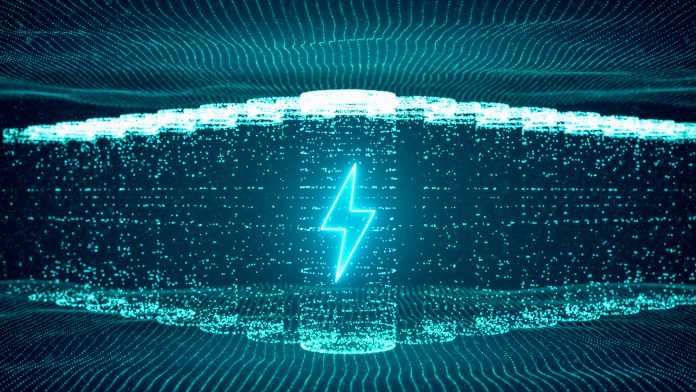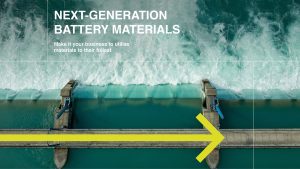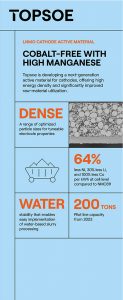LNMO chemistry, defined by its cobalt-free state, high manganese content, and relatively low nickel content, addresses important issues relating to material efficiency, critical metals, and cost. Jeppe Winther Hedegaard, Senior Business Development Manager at Topsoe, provides an insider perspective.
The production of clean transportation fuels, and the development of sustainable solutions for said production, are both vital to the global energy transition. This emerging reality is the main driver of business at Topsoe, which strives to enable the global transition of heavy industry and transport from a carbon-heavy present to a zero-carbon future.
Topsoe is a leading developer and provider of technologies, catalysts, and services for producing fuels and chemicals essential to the energy transition. For over 80 years, the company has been perfecting chemistry to support industries to produce more efficiently.
Over the last nine years, Topsoe has made significant advances in the development of next-generation, cobalt-free, high-manganese LNMO-cathode material, addressing important issues relating to cost and the raw material supply chain. To learn more about the company’s development and current focus, The Innovation Platform spoke with Jeppe Winther Hedegaard, Senior Business Development Manager at Topsoe.
Can you provide a brief overview of Topsoe as a company, its history, and its progression? What are your main values and objectives as a company?
Topsoe is a company built on science and innovative technologies. Established more than 80 years ago by Dr Haldor Topsøe, we have a rich history of taking on some of the world’s toughest challenges.
Chemistry is the foundation of almost any product or fuel that defines modern life, and it will be just as important in shaping the future. We state our commitment to that future in our purpose: “Perfecting chemistry for a better world.”
Thanks to decades of exceptional R&D, we are a global leader in energy-efficient technologies for the production of clean transportation fuels, as well as ammonia, methanol and hydrogen – all of which are universally regarded as the most important fuels and chemicals of the future. We have made it our mission to lead the transition of these production areas into the renewable future; our strategic vision is to be recognised as the global leader in carbon-emission-reduction technologies by 2024.
Reducing carbon emissions is vital to a successful transition toward a renewable economy, and that goal is what leads our company’s actions. Such efforts will make a huge, highly positive difference for our customers, the climate, and the world.
Amongst Topsoe’s varied portfolio of solutions, battery materials is a key focus. Why did you choose to start developing next-generation battery materials for rechargeable batteries, working with LNMO-cathode material in particular?
The development of more effective, cheaper rechargeable battery materials is key to the future of many industries. Utilising our long history within catalysis and surface science – from product development at the nanoscale to fully industrialised manufacturing – we are developing next-generation materials for rechargeable batteries that are safer, faster to charge, more powerful, and cost efficient.
Over the last decade, Topsoe has made decisive progress in the development of lithium nickel manganese oxide (‘LNMO’, or LiNi0.5Mn1.5O4) high-voltage spinel. It is cobalt-free, high in manganese, and relatively low in nickel, allowing it to compete with the performance of today’s mainstream lithium-ion battery technologies.
What are the key benefits of LNMO cathodes and how can they contribute to the global energy transition?
The key benefits of LNMO, compared to high-nickel cathodes, is a raw material cost reduction of 50% per kilogram. The production methods and downstream processes are similar, so this corresponds to a 20-25% cost reduction per kilowatt-hour at cell level. The low cost relies on several factors: LNMO is cobalt-free, transfers 100% more electrons per nickel atom, and transfers 25% more electrons per lithium atom. The high operating voltage of LNMO enables the use of less anode to obtain the same energy.
Nickel and lithium are expensive; with prices fluctuating in recent years, these metals constitute a significant risk factor for price-sensitive applications – such as batteries for the automotive industry – and should be utilised to their fullest from both a cost- and resource-centric perspective. In high-nickel cathodes, 20-40% of lithium is kept in the material to stabilise the structure. This is not necessary with LNMO spinel materials, because the three-dimensional lattice allows for full delithiation of the material without compromising its structural stability. In high-nickel cathodes, nickel is oxidised from Ni2+ to around Ni3+, whereas in LNMO, nickel is oxidised all the way from Ni2+ to Ni4+.
For higher-voltage anode systems, like LNMO-LTO and LNMO-XNO, the high-voltage LNMO-spinel material increases the average cell voltage of systems from 2.2 V to 3 V, compared to NMC-type materials. A Topsoe whitepaper, published jointly with UK-based Echion Technologies, describes how the 3 V LNMO-XNO system provides advantages similar to those of NMC-LTO and NCA-LTO systems – but with up to 55% greater volumetric energy density. This superior performance facilitates a wide range of applications for high-duty-cycle missions – including those relevant for NMC-LTO and NCA-LTO systems – offering greater financial benefit in terms of both total-cost-of-ownership and lifecycle costs, and supporting new applications where other systems’ low energy density fails to address the user-acceptance criteria, including electric ferries, railway rolling stock, automated guided vehicles (AGVs), and mining or construction vehicles.
Lastly, LNMO is compatible with water-based electrode manufacturing. The reason for this is the strong binding of lithium in the LNMO-crystal lattice (hence the high operating potential), so proton-ion exchange is very limited. The avoidance of NMP improves the economy and environmental impact of electrode production.
What is the current status of your LNMO developments and collaborations? How are you working to commercialise and scale-up the production of your LNMO developments?
The battery industry can benefit from Topsoe’s unique technology- and material-science capabilities to develop cathode materials best suited for specific applications.
We believe that successful battery development derives from close collaboration between the customer, cell manufacturer, and battery-chemistry supplier. We therefore continue to devote substantial R&D effort toward customer-specific programmes, jointly engineering specific battery solutions that keep our customers at the forefront of lithium-ion battery performance, cost-efficiency, and material utillisation.
Our ongoing establishment of a 200-ton-per-year pilot plant, at our production site in Frederikssund, Denmark, is an important step towards supporting our customers‘ validation and scale-up plans across 2023. Following successful process and system validation, it is foreseen that large-scale, Europe-based LNMO production will be necessary by 2026.
How important is R&D within your business and how do plan to utilise this in the future?
The synthesis of high-quality LNMO requires detailed understanding and stringent control of the process; even small changes in synthesis procedures have a profound effect on material performance. To obtain reproducible high-quality LNMO, we have used world-class material characterisation facilities, developed for the Topsoe catalyst business, to map out the synthesis process. Using this knowledge, we have been able to tailor the spinel chemistry, crystal structure, and surface morphology to produce LNMO with very low degradation and high capacity.
To bring the LNMO material to market, we are working closely with key stakeholders and leading institutions in the battery material supply chain to strengthen our understanding of the interplay between anode, cathode, and electrolyte – and use that knowledge to further develop both LNMO and other cell components.
Please note, this article will also appear in the eleventh edition of our quarterly publication.










